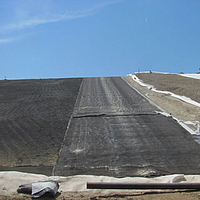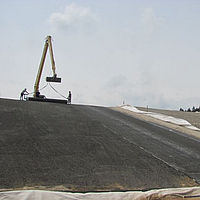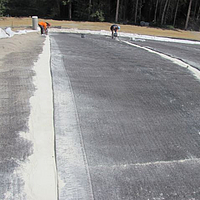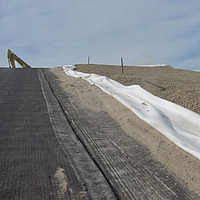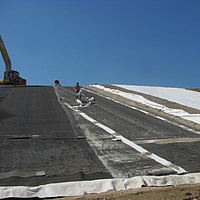Surface sealing
Project information
Landfill „An der Eslarner Straße“
Schönsee, Bavaria, DE
City Schönsee, District Schwandorf
COPLAN AG, Weiden
Max Hilz Bauuntern.GmbH, Spiegelau, installed by Fa. F+T Müller, Ipsheim
March till October 2014
Project details
The town Schönsee, in Germany, lies in the Overpfälzer Forest near the border with the Czech Republic. The site - a former brickyard “An der Eslarner Straße” - was used as a municipal waste disposal site between 1965 and 1977. In addition to household, commercial and industrial waste, it also contained bulk waste. The site served as a clay pit until the 1960s, after which it was used as a landfill. Subsequent to this it was utilised for the disposal of construction waste until the 1990’s. After the closure of the construction waste landfill, the southern area was finally used for the disposal of excavation ma-terials. This fact is important as the municipal region of the town of Schönsee is located in the Oberpfälzer forest nature park and the disposal of excavated materials is not legally permitted. Due to considerable leachate contamination from, the Schwandorf District Office determined that remediation was necessary. In addition to a full engineering analysis and evaluation consider-ing the possible future settlement behavior of the remediated site being undertaken, an extensive deep drilling and dredging cam-paign was implemented during the design stage of the project to accurately determine the waste composition of the site. The level and condition of the groundwater was monitored at five different locations across the site.
Over time, a wide variety of vegetation had settled on the abandoned northern part of the landfill. The existing 350 plus trees were cleared during the winter month in the run-up to the con-struction project, which meant that only the rootstocks had to be removed during the construction phase. After removing the vegetation, site profiling work commenced. During the course of the project it was determined that the relocated waste did not have sufficient bearing capacity to go ahead with the installation of a geosynthetic clay liner. Soil improvement measures had to be carried out, after which, the supporting layer had sufficient load-bearing capacity so that the installation of the LAGA-as-sessed geosynthetic clay liner could begin. The geotextile separating layer, between the sand protection layer and the mineral drainage layer, (the revegetation layer) was a BAM-approved nonwoven. Enkadrain ZB 350 was used as a drainage mat on the GCL within the boundary trench.
Through the incorporation of NaBento RL-N into the cap-ping system, it was possible to deliver the capping system on schedule. The former Schönsee landfill has now been well integrated into the surrounding landscape.

